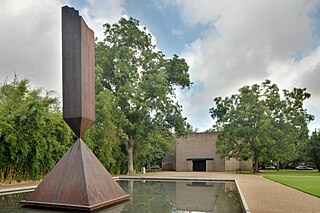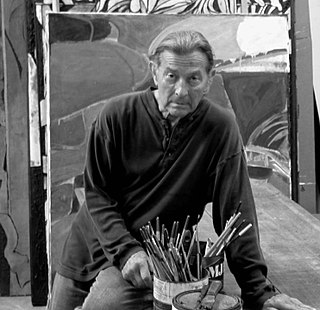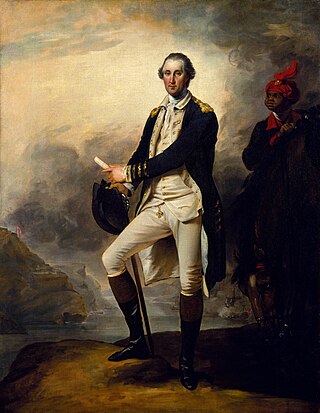
Monochromatic painting has played a significant role in modern and contemporary Western visual art, originating with the early 20th-century European avant-gardes. Artists have explored the non-representational potential of a single color, investigating shifts in value, diversity of texture, and formal nuances as a means of emotional expression, visual investigation into the inherent properties of painting, as well as a starting point for conceptual works. Ranging from geometric abstraction in a variety of mediums to non-representational gestural painting, monochromatic works continue to be an important influence in contemporary art.

Broken Obelisk is a sculpture designed by Barnett Newman between 1963 and 1967. Fabricated from three tons of Cor-Ten steel, which acquires a rust-colored patina, it is the largest and best known of his six sculptures.

Edward Stuart Davis was an early American modernist painter. He was well known for his jazz-influenced, proto-pop art paintings of the 1940s and 1950s, bold, brash, and colorful, as well as his Ashcan School pictures in the early years of the 20th century. With the belief that his work could influence the sociopolitical environment of America, Davis' political message was apparent in all of his pieces from the most abstract to the clearest. Contrary to most modernist artists, Davis was aware of his political objectives and allegiances and did not waver in loyalty via artwork during the course of his career. By the 1930s, Davis was already a famous American painter, but that did not save him from feeling the negative effects of the Great Depression, which led to his being one of the first artists to apply for the Federal Art Project. Under the project, Davis created some seemingly Marxist works; however, he was too independent to fully support Marxist ideals and philosophies.

Robert Indiana was an American artist associated with the pop art movement.

Ellsworth Kelly was an American painter, sculptor, and printmaker associated with hard-edge painting, Color Field painting and minimalism. His works demonstrate unassuming techniques emphasizing line, color and form, similar to the work of John McLaughlin and Kenneth Noland. Kelly often employed bright colors. He lived and worked in Spencertown, New York.

Dance (La Danse) is a painting made by Henri Matisse in 1910, at the request of Russian businessman and art collector Sergei Shchukin, who bequeathed the large decorative panel to the Hermitage Museum in Saint Petersburg, Russia. The composition of dancing figures is commonly recognized as "a key point of (Matisse's) career and in the development of modern painting". A preliminary version of the work, sketched by Matisse in 1909 as a study for the work, resides at MoMA in New York City, where it has been labeled Dance (I).

John Harvey McCracken was a minimalist artist. He lived and worked in Los Angeles, Santa Fe, New Mexico, and New York.

James Jarvaise was an American painter based in Southern California.

Numbers 1-0 is a public artwork by the American artist Robert Indiana, located at the Indianapolis Museum of Art (IMA), which is near downtown Indianapolis, Indiana. This series of sculptures is composed of 10 brightly painted numerical digits, each made of aluminum and set on its own base. Their construction took place at the former Lippincott Foundry in North Haven, Connecticut from 1980 to 1983.

20th-century Western painting begins with the heritage of late-19th-century painters Vincent van Gogh, Paul Cézanne, Paul Gauguin, Georges Seurat, Henri de Toulouse-Lautrec, and others who were essential for the development of modern art. At the beginning of the 20th century, Henri Matisse and several other young artists including the pre-cubist Georges Braque, André Derain, Raoul Dufy and Maurice de Vlaminck, revolutionized the Paris art world with "wild", multi-colored, expressive landscapes and figure paintings that the critics called Fauvism. Matisse's second version of The Dance signified a key point in his career and in the development of modern painting. It reflected Matisse's incipient fascination with primitive art: the intense warm color of the figures against the cool blue-green background and the rhythmical succession of the dancing nudes convey the feelings of emotional liberation and hedonism.

Vase with Poppies is an 1886 oil painting created in Paris, France by Post-Impressionist Dutch artist Vincent van Gogh.

LOVE is an artwork by American pop artist Robert Indiana (1928–2018), located at the Indianapolis Museum of Art at Newfields in Indianapolis, Indiana, United States. It was created in 1970 as the first sculptural form of the artist's 1965 LOVE painting and has been on continuous exhibition at the Indianapolis Museum of Art since it was acquired in 1975.

Memories of Prague is a public artwork by American artist David Louis Rodgers, the Indianapolis Museum of Art at Newfields (IMA), which is near downtown Indianapolis, Indiana.

Visual arts in Israel refers to plastic art created first in the region of Palestine, from the later part of the 19th century until 1948 and subsequently in Israel and the occupied Palestinian territories by Israeli artists. Visual art in Israel encompasses a wide spectrum of techniques, styles and themes reflecting a dialogue with Jewish art throughout the ages and attempts to formulate a national identity.

Minimalism describes movements in various forms of art and design, especially visual art and music, where the work is set out to expose the essence, essentials or identity of a subject through eliminating all non-essential forms, features or concepts. As a specific movement in the arts it is identified with developments in post–World War II Western Art, most strongly with American visual arts in the 1960s and early 1970s. Prominent artists associated with this movement include Ad Reinhardt, Nassos Daphnis, Tony Smith, Donald Judd, John McCracken, Agnes Martin, Dan Flavin, Robert Morris, Larry Bell, Anne Truitt, Yves Klein and Frank Stella. Artists themselves have sometimes reacted against the label due to the negative implication of the work being simplistic. Minimalism is often interpreted as a reaction to abstract expressionism and a bridge to postminimal art practices.
Joachim Pissarro is an art historian, theoretician, curator, educator, and director of the Hunter College Galleries and Bershad Professor of Art History at Hunter College of the City University of New York. His latest book, authored with art critic David Carrier, is called Wild Art. Pissarro was curator at the Museum of Modern Art's Department of Painting and Sculpture from 2003 to 2007.
Ann Temkin is an American art curator, and currently the Marie-Josée and Henry Kravis Chief Curator of Painting and Sculpture at the Museum of Modern Art in New York.

George Washington, also entitled George Washington and William Lee, is a full-length portrait in oil painted in 1780 by the American artist John Trumbull during the American Revolutionary War. General George Washington stands near his enslaved servant William Lee, overlooking the Hudson River in New York, with West Point and ships in the background. Trumbull, who once served as an aide-de-camp to Washington, painted the picture from memory while studying under Benjamin West in London. He finished it before his arrest for high treason in November. The portrait, measuring 36 in × 28 in, is on view in Gallery 753 at the Metropolitan Museum of Art in New York City. Originally in the possession of the de Neufville family of the Netherlands, it was bequeathed to the museum by Charles Allen Munn in 1924.

Andrew Spence is an American artist known for abstract paintings that combine a minimalist vocabulary with playful references to the observed world. In the 1970s and 1980s, he gained recognition as one of a number of younger artists who were re-examining geometric modernism through a contemporary lens that invited humor and reference to everyday objects and life experience into the tradition. Spence's method of distilling visual phenomena into simple, emblematic images has been compared to Ellsworth Kelly, but his work has differed in its more even balance between abstraction and recognition, intuitive approach, and varied, expressive paint surfaces. Art in America critic Ken Johnson wrote that his work maintains "an ironic tension between lofty purism of modernist geometry and earth-bound ordinariness of the vernacular sources." In later paintings, Spence has increasingly obscured the original inspirations of his abstractions, in both form and titling. His work belongs to the permanent collections of the Metropolitan Museum of Art, Museum of Modern Art, and Whitney Museum of American Art, among others. He has received a Guggenheim Fellowship and awards from the American Academy of Arts and Letters and National Endowment for the Arts.






















